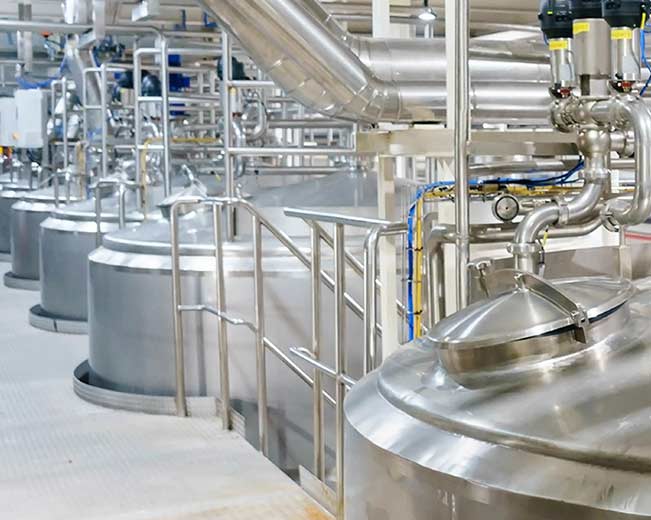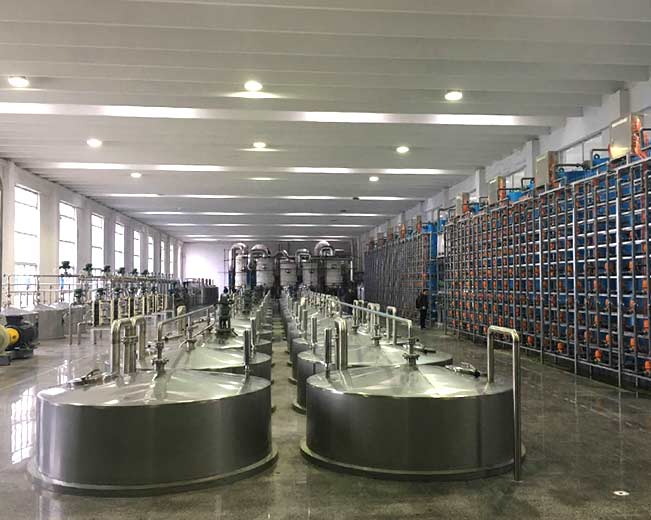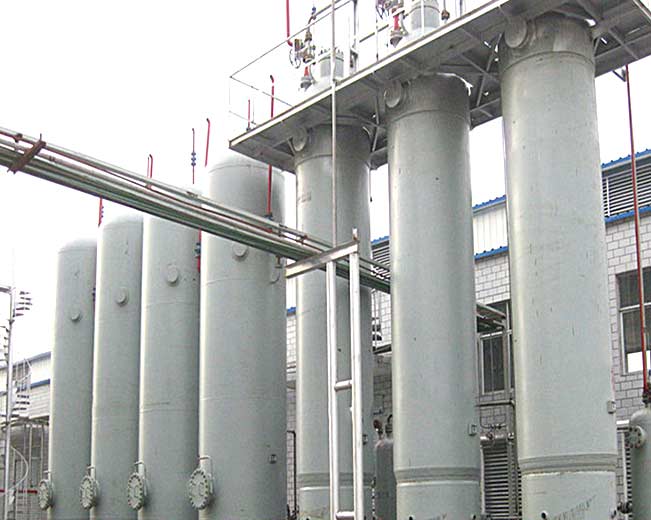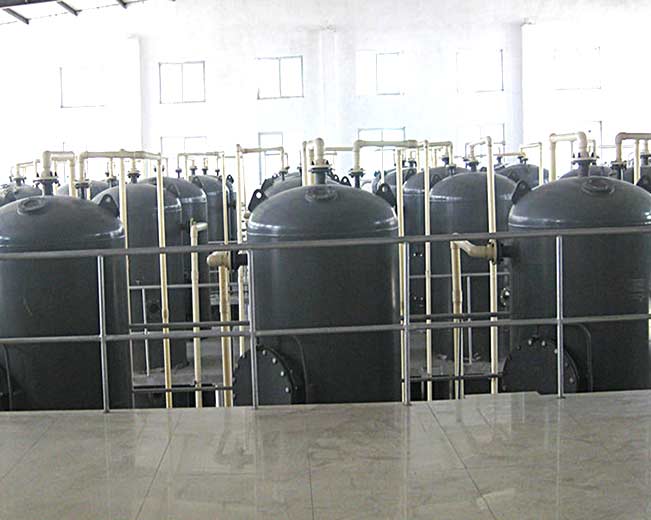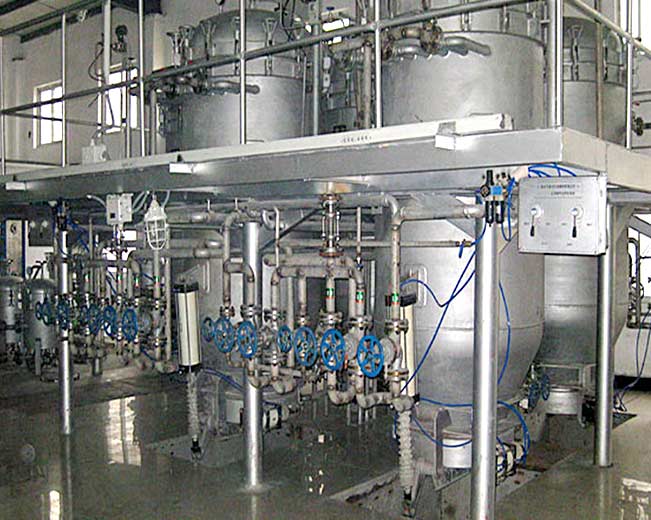Sorbitol production line
Introduction to Sorbitol Sorbitol is an important hexavalent alcohol with the chemical formula CHO. Its sweet taste is relatively pure and basically contains no calories. It is widely used in pharmaceutical raw materials, food, light chemical industry and other industries. Among them, the consumption of sorbitol in toothpaste, cosmetics, food and candy can account for more than half of the total consumption of sorbitol. It can also be used as a raw material for polyether.
Process Description
Taking glucose as raw material, the hydrogenation production method, its technological process can be simply described as follows:
Glucose→hydrogenation reduction→decolorization→isolation→concentration→packaging
Generally, processes such as sugar ion exchange treatment and adjustment are included. The sugar concentration is generally 7.5-8.0 before hydrogenation. If the crystallized glucose is of good quality, it can be treated without ion exchange, but pure water is best for the water used for saccharification. Activated carbon decolorization and ion exchange can be carried out by general decolorization and ion exchange processes. In order to reduce the cost, ordinary sugar activated carbon can be used. This activated carbon is generally produced by the zinc salt method, which often contains a spoonful of salt. Therefore, ion exchange treatment must be carried out after the activated carbon is decolorized. Ion exchange can remove the salt in the sugar solution and further remove some pigments that are not easily removed by activated carbon. The sugar liquid in this process is required to be colorless or extremely pale yellow.
Hydrogenation is generally carried out in a high pressure hydrogenation kettle. There are two main modes of hydrogenation, one is batch hydrogenation in high pressure hydrogenation tank, and the other is continuous hydrogenation. At present, my country mainly adopts intermittent hydrogenation. The pressure of intermittent hydrogenation is 4.0-12.0MPa. Now take the magnetic hydrogenation kettle as an example, its typical operation is as follows:
Introduce hydrogen into the autoclave and the pressure reaches 0.2Mpa-0.01Mpa, then depressurize to the point where hydrogen is introduced, and then depressurize again. At this time, take samples to measure the purity of hydrogen, and keep the pressure to ensure that the oxygen content in the hydrogen meets the requirements. The 0.25% glucose solution was pumped into the autoclave with a high-pressure feed pump, the nitrated catalyst was put into the glucose feed metering tank, mixed with the sugar solution, and then pumped into the autoclave with a high-pressure feed pump.
At this time, the catalyst and sugar liquid should be mixed well and pumped into it. Since the catalyst has a relatively high relative density, it is easy to wear the feed pump. Therefore, the sugar liquid with catalyst should be fed when the sugar liquid is fed. Then use the rest of the sugar liquid to flush the pipeline and pump, and put them into the hydrogenation kettle together. After the feeding is completed, the hydrogenation kettle is turned on and stirred. The stirring speed is related to the structure of the stirring blade. The stirring should ensure that the three phases of the catalyst sugar liquid and hydrogen gas, solid and liquid are fully mixed, and dispersed waves can be formed on the liquid surface at the same time. Guarantee the best hydrogenation effect
Under the condition that the catalyst performance is good and the sugar liquid is in a good state and the sugar liquid is fully stirred, after the reaction is completed, the jacket cooling water is turned on, and the temperature of the feed liquid is lowered to about 50%. Stop stirring, let it stand for about ten minutes to allow the catalyst to settle, and you are ready to discharge. During the standing period, there is a small amount of hydrogen absorption process.
Open the discharge valve, and use the hydrogen in the kettle to press out the sugar in the kettle under high pressure. In order to reduce the loss of catalyst entering and leaving the autoclave, there should be a certain distance between the discharge pipe and the bottom of the autoclave in the design of the autoclave, and this distance basically corresponds to the volume of the catalyst in the autoclave after sedimentation. In this way, after the hydrogenation is stopped, most of the catalyst settles to the bottom of the kettle after a settling time of about ten minutes.
Due to the high pressure in the autoclave, after the feed liquid is discharged from the autoclave, the feed liquid must pass through a gas-liquid separator to separate the liquid from the steam hydrogen. This gas-liquid separator is placed at a relatively high place, which can not only ensure safety, but also A material plug can be formed on the material in the autoclave to ensure that the hydrogen in the autoclave does not leak when the autoclave is unloaded.
The hydrogenated liquid discharged from the autoclave is sent to a gas-liquid separator, the steam and dissolved hydrogen are discharged from the upper part of the separator, and the hydrogenated liquid enters the settling tank from the lower part of the gas-liquid separator. The function of the settling tank is to recycle the catalyst discharged with the feed liquid. Since this part of the catalyst is very fine, the settling is very slow. In the past, two sets of sedimentation tanks were generally used, and part of the catalyst would flow out with the hydrogenation liquid, resulting in the loss of the catalyst. At present, some factories use magnetic separators to adsorb the active part of the catalyst on the magnetic drum on the magnetic separator, and the deactivated catalyst enters the next step with the feed liquid. The catalyst adsorbed on the magnetic drum is recovered and returned to the hydrogenation kettle. With this magnetic separation method, one settling can be reduced and the catalyst can be fully utilized.
The feed liquid after hydrogenation generally contains a small amount of spent catalyst, the salt added at the time of adjustment and the pigment produced by high temperature and high pressure, so it must be refined and decolorized. It can be purified by general decolorization and ion exchange. The feed liquid of pH after refining and decolorization is clear and transparent, and can be controlled at 5~7 by ion exchange method. In order to further improve the quality of the product, fine filtration can be used to further improve the transparency of the product. For example, microfiltration can be used to remove the turbidity caused by a small amount of protein and colloid. The refined sugar solution is sent to concentration. A drum evaporator can be used, or a double-effect or triple-effect tubular evaporator can be used. In order to improve the quality, a multi-effect thin plate heat exchange evaporator can be used. Concentrate the refined liquid to 70% scoop concentration, which is the finished liquid sorbitol.
Huatai advantage
Huatai Group can undertake medium and large sorbitol production lines, and can design, develop, produce, and install a full set of medium and large sorbitol production lines. We can provide you with a complete set of turnkey projects from process design, equipment layout, civil engineering planning and design, automation control, equipment manufacturing, installation and commissioning to personnel training, after-sales service, etc., to solve various problems in the construction and production process for you in all aspects.


